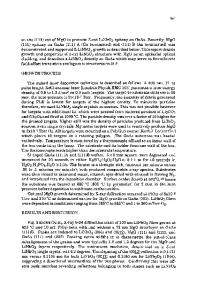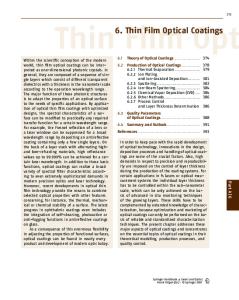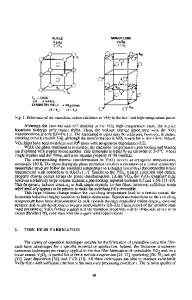Thin Film Epitaxial Oxide Optical Waveguides
- PDF / 4,012,368 Bytes
- 12 Pages / 414.72 x 648 pts Page_size
- 109 Downloads / 403 Views
ABSTRACT One of the most challenging applications of ferroelectric thin films is the formation of technologically practical optical waveguideing devices, particularly in the context of a dynamically changing environment where competing light sources and optical materials simultaneously undergo rapid improvement. In order to assess the prospects of this technology, a fundamental understanding of waveguide loss is being pieced together. This includes the relative contributions of surface scattering, and grain boundary scattering to optical losses. With computational models, it is possible to predict the surface losses from measured topographic data. This tool provides a method to probe the residual effects of grain boundaries, defects and impurities on optical losses. A comparative anatomy of various thin film structures and their loss characteristics will be provided in the context of these experiments. INTRODUCTION Electrooptic devices such as fast (>20 GHz) modulators are one application' of ferroelectric oxide thin film waveguides. A compact, blue laser source of a few milliWatts power capable of lasting thousands of hours is of great interest as applied to optical data storage and xerography, 2 and is the primary focus of our research. Ferroelectric oxide thin films offer several
advantages over bulk materials for optical waveguides, though no devices superior to bulk devices exist yet. One advantage is the larger refractive index difference between the ferroelectric layer and the cladding, which are dissimilar materials, such as lithium niobate and sapphire. Bulk devices rely on ion-exchange to produce an index change, which produces only a small index
difference. Thin films therefore permit higher intensity per unit power in the guide, and hence larger non-linear effects, and shorter interaction lengths. To be effective, the thin film devices must meet several challenges. Cost and performance in comparison to bulk devices are only two. One major challenge awaiting all frequency doubled blue sources is direct blue laser sources, particularly in light of the report of efficient gallium nitride light emitting diodes3 and the great research interest in gallium nitride lasers. Our research on thin film ferroelectric waveguides has concentrated on lithium niobate and lithium tantalate thin films on sapphire. An earlier publication detailed the external conversion efficiency of such waveguides as a function of film thickness. 4 To summarize these results, the optimum film thickness is about 400 nm, and the theoretical conversion efficiency of an ideal, lossless device is over 100 times larger than the present state-of-the art in bulk devices. There is a great challenge in exploiting this property however since for a frequency doubling device relying on copropagating modes, losses of 2 dB/cm reduce the conversion efficiency by about 50%. Another advantage of thin film optical heterostructures, is the ability to grow waveguides on diverse substrates, such as semiconductors. Such structures could have a packaging cost
Data Loading...











